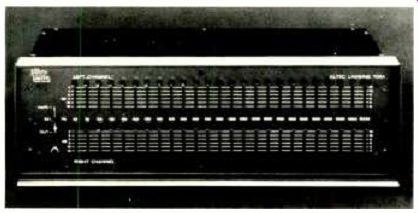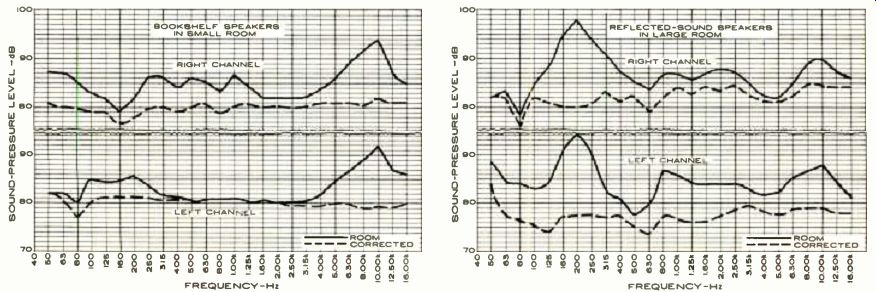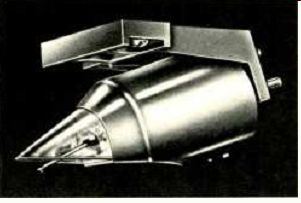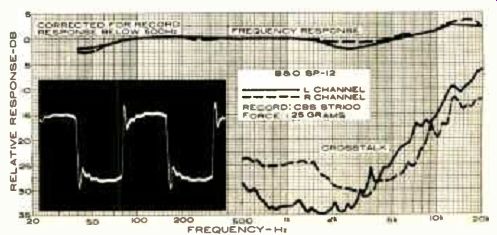by Hirsch-Houck Labs
Altec-Lansing 729A "Acousta-Voicette"; B&O SP-12 Phono Cartridge
Altec-Lansing 729A "Acousta-Voicette"
In the continuing quest for flat frequency response throughout a hi-fi system, the speaker has rightfully received the greatest attention. While there is room for argument as to what actually constitutes "flat" frequency response for a speaker, there is general agreement that undue emphasis or deemphasis of any part of the spectrum, or the presence of peaks or holes in a measured response curve, are undesirable qualities.
No matter how "perfect" a speaker may be, the characteristics of the listening room have a profound effect on the system response at the listener's ear. Standing-wave patterns and absorption of high frequencies by room furnishings negate much of the speaker designer's efforts.
In recent years Altec- Lansing has developed a technique, which it calls "Acousta-Voicing," for modifying the combined response of speaker and room as required for optimum flatness of response at a specified listening position. Originally intended for commercial sound installations, the voicing system employs narrow-band adjustable filters, each covering 1/3 octave, which can remove relatively narrow band response irregularities without affecting adjacent frequencies.
The process is quite complex, and normally makes use of "pink" noise speaker excitation (having constant energy per octave of bandwidth), calibrated pickup microphone, and a real-time spectrum analyzer to display the entire audio spectrum : t a glance while making adjustments. Because of the specialized and expensive test equipment required, plus a considerable number of engineering hours, voicing would hardly seem to be practical for the home.
Evidently Altec-Lansing thought otherwise and the result was the Acousta-Voicette 729A stereo equalizer. The 729A has two sets of 1/2-octave active filters, 24 for each channel, with center frequencies between 63 and 12,500 Hz. The loss in each 1/2-octave band is adjustable from 0 to 12 dB, with a vertical slider potentiometer. Each stereo channel has a re-insertion gain control, able to add up to 17 dB of gain to compensate for equalization losses.
The 729A is a rather large black box, 18 3/,1" wide by 6" high by 8" deep. It is inserted in the tape-monitoring circuits of an amplifier or receiver. A switch on its panel cuts the equalizer in or out, or restores the tape-monitoring functions when a recorder is connected to the jacks on the 729A. Obviously. with 48 equalization adjustments, it is out of the question to balance a system by ear. The best way is still to use a pink-noise signal and spectrum analyzer, and this is the method employed by Altec when installing the 729A or its professional counterparts. However, the company has also made it possible to set up the device with a more modest equipment outlay. A special test record is supplied with the 729A. It has 1/2-octave bands of noise, centered at frequencies corresponding to the filters of the 729A, from 50 to 16,000 Hz, plus white-and pink-noise bands. The only test instrument required is a sound-level meter, or (as we used) a wide-range microphone and a.c. v.t.v.m. for reading its output voltage. The final equalization can be no better than the accuracy or flatness of the microphone or sound-level meter, which must be of professional quality. Instruments made by Bruel & Kjaer, General Radio, Hewlett-Packard, and H. H. Scott are suitable, with prices ranging from about $300 to over $1000. If this seems expensive, consider that the real-time spectrum analyzer used by Altec engineers costs about $10,000. The procedure is simple. One speaker at a time is equalized. The microphone is placed at the preferred listening location. The test record is played, obviously with a pickup and amplifier having essentially flat response between 50 and 16,000 Hz, and sound-pressure readings taken at each test-band frequency. When these are plotted on a special graph supplied with the 729A, the result is what is called the "house curve"-the actual response of the speaker and room combined, at the listening point.
The equalizer controls corresponding to the major peaks in the house curve are then adjusted to compensate for them, and the test is repeated. Since each adjustment has some effect on adjacent frequency bands, it is necessary to repeat the process several times. In our case, we found three sets of measurements to be sufficient to get a reasonably flat response curve. The other speaker is then equalized in the same manner. It took us about 2 hours to do a complete voicing on a stereo system.
While listening to program material, the two reinsertion gain controls are set for equal loudness when the equalizer is switched in and out, and for channel balance. A transparent plastic cover is then installed over the control panel of the unit to prevent accidental movement of the controls. It is also a good idea to record the control settings for reference.


----------
Electrically, we confirmed the specifications of the 729A. It has unity gain with no reinsertion gain added and its intrinsic harmonic distortion is less than 0.32% up to 1.0 volt output. This increases to 0.66% at 2 volts and to 1% at 3 volts, but few amplifiers require more than 1 volt at their tape inputs for full output.
To evaluate the effectiveness of the 729A, we used it to equalize two very different listening rooms. One (our lab) is a small room, with two compact bookshelf speakers of good quality at one end. The house (room) curve showed a large peak at about 10 kHz, with an amplitude of 12 or 13 dB, and relatively little irregularity at lower frequencies. The final (corrected) response curve shows how the over-all response was adjusted to within ±2 dB from 50 to 16,000 Hz, except for slight dips at 80 and 160 Hz. We probably could have eliminated these, but did not consider it necessary.
The response curve of the 729A equalizer which flattened out the house curve is essentially the inverse of that curve.
We were disappointed in the audible results. The system sounded dull and lifeless with the high-frequency peak eliminated. We suspect that this was due to the proximity of the listening position to the speakers (about 6 to 8 feet), which resulted in our flattening out the direct response, approximately on axis, rather than the over-all output of the speakers in all directions, which is what our ears ultimately heard.
The second installation was more typical. It was in a living room with a pair of good-quality reflected-sound speaker systems. Here the microphone was about 18 feet from the speakers, and very little direct sound reached it. The house (room) curve showed a large peak at about 200 hz, which had always been audible as a heaviness, or coloration, on male voices. It was due to an unfortunate combination of a smaller speaker peak at that frequency, and a room resonance which reinforced it.
The 729A readily smoothed out the over-all response to within ±3 dB from about 50 to 16,000 hz. In this case the improvement in sound quality was dramatic, with a neutral character having no trace of "boom" or unnatural heaviness, yet fully supported by a solid low bass when supplied by the program. Although the voicing was done at one point in the room, it seemed equally effective at other positions.
Our conclusion is that the Altec 729A can probably clear up most "difficult" hi-fi listening situations caused by room effects. It can, of course, correct some speaker deficiencies, but is a rather expensive way to do this. Priced at $799, it is cheaper than a specially designed listening room and may well be the best alternative to that course. We think it makes economic sense to buy the best speakers you can afford and use the 729A to supply the finishing touches to a really deluxe music system. It is obviously not for everybody, but is not a "gimmick" and it does its job very effectively
------------
B&O SP-12 Phono Cartridge

FOR many years, the Bang & Olufsen cartridges, made in Denmark, were marketed in this country by Dynaco. B&O is now distributing the latest version of this distinctive cartridge under its own name, through Bang & Olufsen of America, Inc. The cartridge is known as the SP-12 or SP-10, depending on the stylus dimensions. The SP-10 is fitted with a 0.6-mil conical diamond, while the SP-12, which we tested, has a 0.2 X 0.7-mil elliptical diamond stylus. The styli are interchangeable and easily replaced by the user.

-------
The SP-12 uses the "X "-shaped armature design that has characterized the company's earlier cartridges. All moving parts-stylus, cantilever, and armature-are in the replaceable stylus assembly, which includes a magnetic shield. The main cartridge body contains the magnet and four coils whose pole pieces protrude slightly and are close to the four tips of the armature. The generating system is symmetrical, and is not particularly sensitive to induced hum from external magnetic fields. There is some magnetic attraction between the cartridge and a steel turntable and even though it is not great, the low tracking-force requirement of this cartridge makes it advisable to use it only with non-ferrous turntables (as is virtually every modern turntable). The B&O SP-12 is designed for a 15-degree vertical tracking angle. Its physical shape is such that any appreciable vertical-angle error (on the low side) will cause the cartridge body to contact the record surface. It, therefore, is supplied with a removable plastic wedge that tilts the entire cartridge body by 3 degrees when it is installed in the arm of an automatic turntable. This produces a vertical angle of 18 degrees when playing the first record and 12 degrees when playing the tenth record of a stack. This ±3-degree error is insignificant from a performance standpoint and assures that the cartridge body will clear the record at all times. If it is installed in a Dual 1219 or P-E automatic turntable, both of which have adjustable vertical tracking angle features, this wedge is not needed, nor is it required with a properly installed manual record-player arm.
Playing the CBS STR100 test record, the B&O SP-12 had a very uniform response (within ±2.5 dB) all the way to the 20,000 Hz upper limit of the record. Channel separation was 25 to 35 dB at middle frequencies, 15 to 20 dB at 10,000 Hz, and 10 to 15 dB at 20,000 hz.
The excellent high-frequency response of the cartridge encouraged us to check it with the CBS STR120 record, which sweeps from 500 to 50,000 Hz. On one channel, the response was essentially uniform to 25,000 Hz, and on the other it went to 30,000 Hz.
Stereo separation was maintained all the way to the uppermost frequency limits of the cartridge.
The cartridge is rated for tracking forces between 1 and 2 grams. We found L25 grams necessary for best tracking of the 1000-Hz 30-cm /s bands of one of our test records. The IM distortion, with the RCA 12-5-39 record, was low up to about 17-cm /s velocity with a 1.25-gram force, and up to 23 cm /s at a 2-gram force. The response to the tune bursts on the STEREO REVIEW SR12 test record was excellent, although we could see second-harmonic distortion on bursts in the 10-to 20-kHz range. The output of the cartridge was 4.3 millivolts at 3.54 cm /s. We measured the effect of shunting capacitance on the response, and would judge that total capacitances up to about 300 to 350 pF have negligible effect on the response.
In our largely subjective test of tracking ability, the cartridge acquitted itself well. It ran a close second to two or three of the best cartridges we have tested. At no time did it mis-track seriously-in fact, it was necessary to listen quite carefully to detect the slight mistracking that occurred on a few of the highest level bands of the Shure TTR1O1 "Audio Obstacle Course" record.
B&O emphasizes its use of a diamond mounted directly on the cantilever without an intermediate cup or bushing, which would add undesirable mass to the moving system. Its success is obvious from the outstandingly wide range and flat response of this cartridge. Each cartridge comes with its own individually run response curve, which agreed quite closely with our own measurements. In fact, we were pleasantly surprised to find that our tests confirmed every published claim made for the cartridge, even though we used different types of test records.
This is not, by any means, a usual occurrence in cartridge testing.
When playing records with the cartridge it is difficult to assign any special character to the sound. This is a logical result of its smooth, wide-range response, which gives it a very neutral quality. This highly desirable property means that the cartridge will reproduce records faithfully, without imposing any of its own characteristics on the sound. The B&O SP-12 stereo phono cartridge sells for $59.95.
Also see: Test Equipment Product Report
New Modular Color-TV Receiver, Eugene Lemke